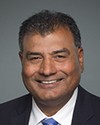Good afternoon, everyone. My name is David Arnold. I am the chief migration officer. I work for the Department of Immigration and Border Protection as part of the Australian government. I'm a posted officer here at our high commission, just down the road on O'Connor Street.
We thank you for the opportunity to present today and talk a little about some of the client service modernizations that my department has been undertaking over the last couple of years, and certainly what we're looking to do into the future.
My department manages millions of entries into and departures from Australia of temporary visitors and permanent migrants, as well as Australian citizens. This includes the monitoring and resolution of their status, and the promotion of values and Australian citizenship.
Our visa system plays a key role in promoting Australia's economic and social prosperity. Australia has a universal visa system—that is, every single individual who wishes to travel to Australia for temporary or permanent purposes is required to have a visa before they board their method of travel.
The department already manages a significant volume of activities through digital channels. One such example is our electronic travel authority, which I know Canadians have introduced recently; as well as our ImmiAccount, an online portal for visa applicants; and SmartGate. Like Canada, we have traditionally had front-line officers doing a passport check and an admissibility check, like a border service officer here. We've moved that to more automation through SmartGate, using e-passports and biometric capture.
ImmiAccount, in particular, has been quite a success for us in moving clients away from higher-cost channels such as face-to-face ones and by telephone. Individuals who make application to travel to Australia are required to establish an ImmiAccount. It's not dissimilar from, say, setting up an Internet banking facility with your financial institution. It acts as our front door. Since its launch in 2013, it has grown significantly. Clients are able to access 41 forms, essentially 41 visa types to travel to Australia. It generates in excess of $1.1 billion a year in revenue through visa application charges.
Last financial year, we received more applications via ImmiAccount than we did paper applications. Applications lodged via ImmiAccount are 100% electronic. We have no paper files for those applications. Approximately 18 months ago, Australia moved away from the issue of foil; we refer to it as a “visa label”. There is no longer any legislative means to issue a foil to a visa applicant or visa holder to Australia. For example, in the very limited processing that some of my staff do here in Ottawa, we don't see passports. That has enabled the department to set up a rather agile and responsive service delivery network, where we can pick up visa applications and caseloads and move them very quickly depending on the issues—for example, post-natural disasters or generally big demand, such as during Chinese New Year.
We are moving our eLodgement to our biggest caseloads in the foreseeable future, which will be Chinese nationals and Indian and Indonesian applicants. We do partner with service delivery agencies, as Canada does. Those organizations at the moment accept applications on our behalf via paper. That will soon move to digital for those particular markets, which will enable us to move our most significant caseloads around our service delivery network.








